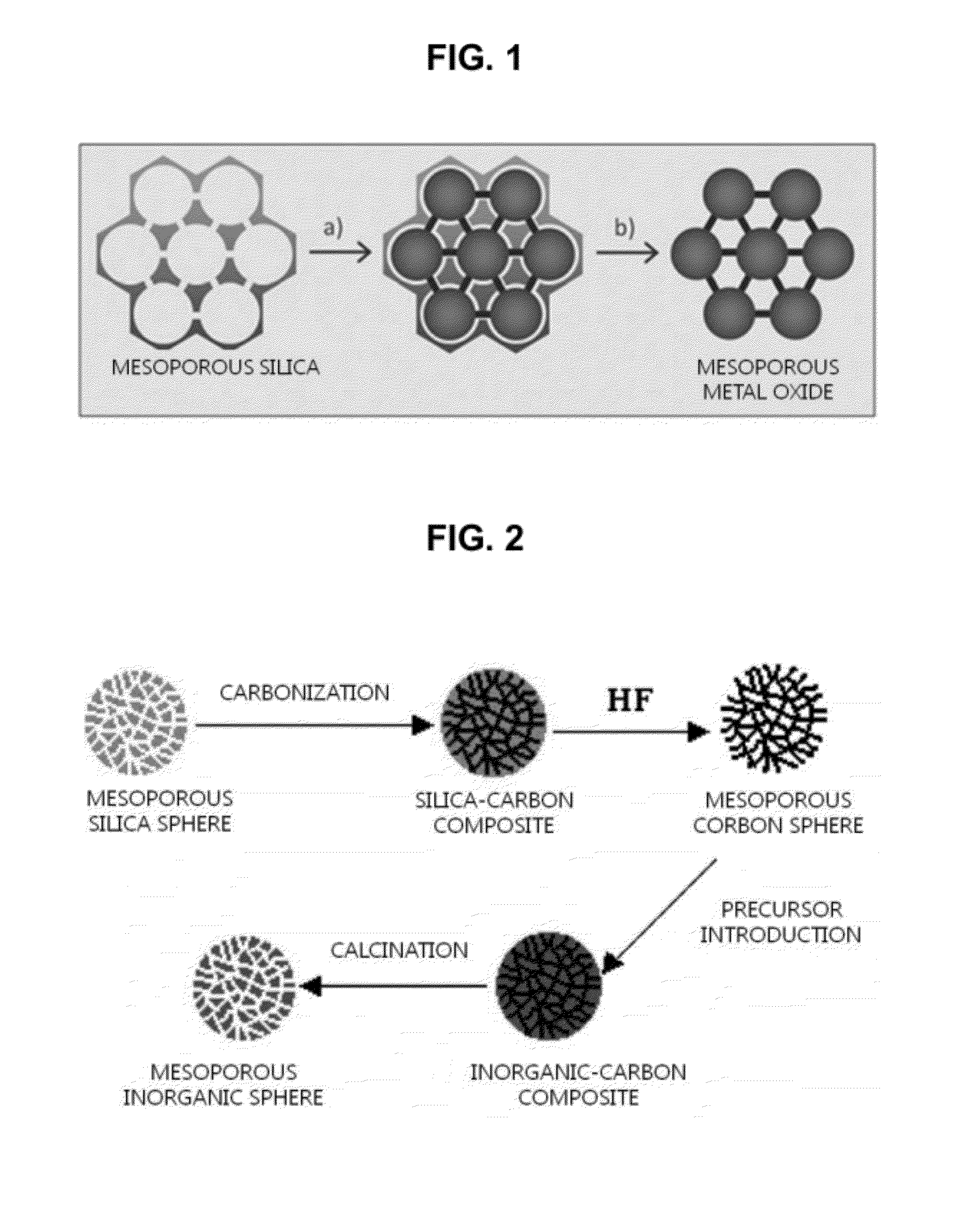Method of manufacturing porous metal oxide
a metal oxide and manufacturing method technology, applied in the direction of metal/metal-oxide/metal-hydroxide catalysts, catalyst activation/preparation, metal/metal-oxide/metal-hydroxide catalysts, etc., can solve the problems of silica template melting and metal oxide, not yet provided uniform catalyst dispersion, etc., to achieve effective use, large surface area, and high sensitivity
- Summary
- Abstract
- Description
- Claims
- Application Information
AI Technical Summary
Benefits of technology
Problems solved by technology
Method used
Image
Examples
example 1
Manufacture of the Inventive Porous Metal Oxides (SnO2)
[0042] Preparation of metal-organic frameworks (MOFs)
[0043]1.1 g of K2PdCl4 and 3.6 g of 2-hydroxypyrimidine hydrochloride were dissolved in water, and the reaction mixture was stirred at room temperature for one hour.
[0044]The reaction solution was washed with water to obtain microcrystalline powder. The microcrystalline powder was dispersed in water, and the resultant solution was adjusted to pH 6 in the presence of NaOH and stirred for five days to obtain palladium (Pd) ion-containing MOFs (Pd-MOFs) (897 mg, yield 90%). The resultant Pd-MOFs were determined to have a BET surface area of 10 to 2000 m2 / g.
[0045] Preparation of porous metal oxides SnO therein including uniformly dispersed catalysts (Pd)
[0046]200 mg of Pd-MOFs prepared in Step 1 were dispersed in a solution of 10 g SnCl2 in 1L anhydrous ethanol, and the reaction solution was stirred at room temperature for 24 hours.
[0047]Then, SnCl2-impregnated MOFs were isolated ...
example 2
Preparation of the Inventive Porous Metal Oxides (In2O3)
[0051]200 mg of Pd-MOFs prepared in Step 1 of Example 1 were dispersed in a solution of 10 g In(NO3)3 in 1L anhydrous ethanol, and the reaction solution was stirred at room temperature for 24 hours.
[0052]Then, In(NO3)3-impregnated MOFs were isolated through centrifugation, dried at 40° C. for one hour and calcined at 900° C. for two hours to remove the organic materials of the MOFs.
[0053]Through such a procedure, the metal oxide precursor In(NO3)3 is converted to In2O3, and the catalytic metal Pd of the MOFs is present in the metal or metal oxide form.
[0054]Element analysis was performed for the resultant porous In2O3 to determine the ratio of the catalytic metal Pd and In2O3. In order to satisfy with the desired ratio of the catalytic metal Pd and In2O3, the impregnation of the metal oxide precursors in the MOFs, the drying and the calcination were repeatedly performed.
[0055]Finally, porous In2O3 with 1 wt % of catalytic metal...
PUM
| Property | Measurement | Unit |
|---|---|---|
| total weight | aaaaa | aaaaa |
| surface area | aaaaa | aaaaa |
| diameter | aaaaa | aaaaa |
Abstract
Description
Claims
Application Information
 Login to View More
Login to View More - R&D
- Intellectual Property
- Life Sciences
- Materials
- Tech Scout
- Unparalleled Data Quality
- Higher Quality Content
- 60% Fewer Hallucinations
Browse by: Latest US Patents, China's latest patents, Technical Efficacy Thesaurus, Application Domain, Technology Topic, Popular Technical Reports.
© 2025 PatSnap. All rights reserved.Legal|Privacy policy|Modern Slavery Act Transparency Statement|Sitemap|About US| Contact US: help@patsnap.com



